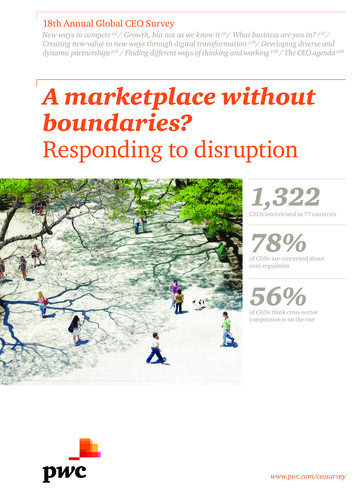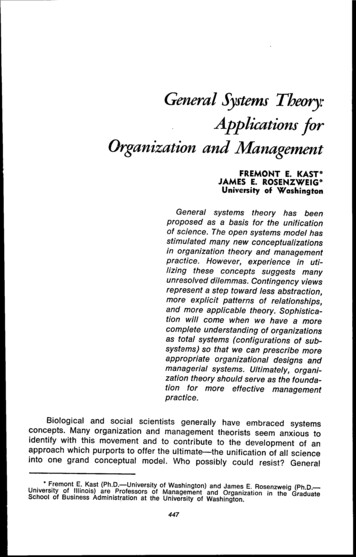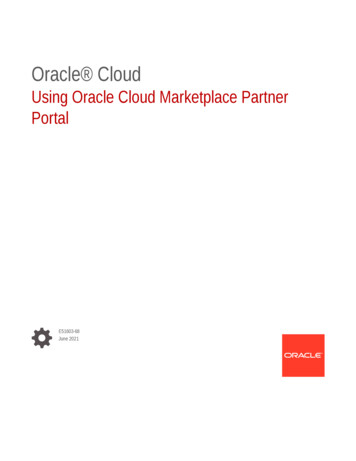
Transcription
18th Annual Global CEO SurveyNew ways to compete p2 / Growth, but not as we know it p6/ What business are you in? p12 /Creating new value in new ways through digital transformation p18/ Developing diverse anddynamic partnerships p24 / Finding different ways of thinking and working p28 / The CEO agenda p34A marketplace withoutboundaries?Responding to disruption1,322CEOs interviewed in 77 countries78%of CEOs are concerned aboutover-regulation56%of CEOs think cross-sectorcompetition is on the risewww.pwc.com/ceosurvey
ForewordNew ways tocompeteGiven the scale of the challenges anduncertainties that today’s CEOs face in globalmarkets, it’s little wonder that the one ‘musthave’ attribute they point to for future successis adaptability. It’s clear that in 2015, disruptivechange will affect all global markets. But whileCEOs are less confident overall about theprospects for the global economy, many believethat there are significant opportunities for theirown business to grow in the year ahead.Macroeconomic trends are continuing in thedirection we highlighted in last year’s survey.While overall, global growth prospects couldbest be described as modest, there are pocketsof greater dynamism. Mature markets –particularly the US, which for the first timein five years ranks above China as CEOs’ keymarket for growth – look likely to offer thebest prospects in the near term. The emergingeconomies – notably the BRICS, which havebeen such powerful engines of expansion –are now grappling with political and structuralchallenges. However, underlying drivers ofgrowth, such as youthful populations and a fastgrowing middle class, make many emergingeconomies attractive prospects for the future.The challenge for CEOs, in such a fast-changingenvironment, is where to place their bets.It’s not simply economic fundamentals thatworry CEOs. Over-regulation is cited by 78% asa concern. And these concerns are not limitedto industry-specific regulations but go muchbroader into areas like trade and employment.Cyber threats have increased markedly and arelikely to become even more prominent in thewake of the recent high-profile attacks onentertainment networks. The rapid pace oftechnological change – seen as a challenge by58% of CEOs – is also highlighting a shortageof key skills that could imperil growth.But CEOs no longer question the pace oftechnological change, as they learn to deal withit. The majority of CEOs believe that investmentsin digital technologies have created value fortheir business, and around 80% say that mobiletechnologies and data analytics are key strandsof their strategy.The challenges thrown up by these changes areset against a competitive landscape that is alsorapidly and radically reshaping. Competition isnow coming from new and previously unseensources. A wide range of industries is beingdisrupted by regulatory changes, increasingcompetition and new patterns of consumerbehaviour. With that in mind, one-third ofCEOs say they have entered new industries inthe last three years, and more than half (56%)believe that organisations will increasingly becompeting in new sectors in the next three years.
PwC 18th Annual Global CEO Survey54%of CEOs have entered anew sector, or consideredit, in the past three years.45%of CEOs do not think thatcooperation betweengovernments is leadingto greater movement ofskilled labour betweenmarkets.Dennis M. NallyChairman, PricewaterhouseCoopersInternational Limited3As well as new areas of competition, CEOsare also looking to collaborate more with adiverse range of partners that can provideaccess not just to new markets and consumers,but crucially, to the new and emergingtechnologies and innovation that they consideressential to achieve growth. CEOs are thereforebuilding diverse collaborative networks thatembrace not just traditional partners, butcustomers, academia, NGOs and evencompetitors. Managing those networks willbe increasingly important for future success.Diversity, too, is becoming a crucial qualityin the talent pool that CEOs must draw on tocompete. Talent diversity and inclusivenessis no longer seen as a soft issue. It’s now a corecomponent of competitiveness – and most CEOs(77%) have, or intend to adopt, a strategy thatpromotes it.My sincere thanks go to the more than 1,300company leaders from 77 countries who sharedtheir thinking with us. Their active and candidparticipation is the single greatest factor in thesuccess of PwC’s Annual Global CEO Survey,now in its 18th year. We greatly appreciate ourrespondents’ willingness to free up their valuabletime to make this survey as comprehensive andaccurate as possible. We’re especially gratefulto the 33 CEOs who sat down with us to holddeeper and more detailed conversations. You’llsee their comments throughout this report.
ContentsWe live in an era of unprecedenteddigital change – the type of changethat is reshaping the relationshipbetween customers and companies,breaking down the walls betweenindustry sectors, and, by extension,prompting forward-thinking CEOs toquestion the very business they’re in.To navigate this digitally-led economy,business leaders will need to understandhow technology can improve theiroperations and bring them closer totheir customers; embrace collaborationboth inside and outside the business;and identify a rich and varied talentpool. More than anything, though,they’ll have to develop a flexiblevision that allows them to pinpointtheir company’s strengths even astheir customers, sectors and marketschange in front of their eyes. Soundlike a superhuman challenge?Welcome to 2015.Growth6Time for a reboot6The new economicequilibrium7Causes for concern9Getting to grips withdisruption10
PwC 18th Annual Global CEO 245Final words281834Rethinking customervalue12The art of understanding 19Go tech young man25The right mix of talent28The CEO agenda34Unlikely alliances25Easier said than done31Soft skills3413Once more into thesecurity breach21A few key capabilities3616Identifying thepotential of technology2227How can you createsuccessful partnerships?Can’t get enough data?What’s the hold up?Meet the CEOs38Research methodologyand contacts40Credits41Notes and sources42
GrowthGrowth, but not aswe know it61%of CEOs see moreopportunities todaythan three years agoEvery business in today’sworld has opportunitiesand threats, so the keyquestion for us is not topredict whether or notwe have threats oropportunities. [It’s]whether or not we canbe.flexible enough to beable to detect those threatsor opportunities. And ofcourse react to them.Victor KislyiExecutive Chairman & CEO,Wargaming Public CompanyLimited, CyprusTime for a rebootIf 2014 taught us anything it’s that in ourincreasingly technology-led world, no industry,no company and no government, even, isimmune from the effects of change. Take theglobal energy market, where breakthroughinnovations continued to shake up the statusquo. Or the corporate world, where a cybersecurity attack had international security anddiplomacy ramifications. And what about thatdigital transport start up – barely four years old– challenging the entire global taxi industry’sbusiness model and receiving an 18 billionvaluation for its chutzpah.Of course, digital change throws up as manyopportunities as risks. We think that’s whythere’s an underlying sense of optimism formany CEOs, despite the picture they’re paintingthis year of an increasingly fluid and disruptedbusiness environment.We asked CEOs whether they see moreopportunities for their business today thanthree years ago, and also whether they see morethreats over the same period (see Figure 1). It’splain that business leaders see more of both.Figure 1 CEOs see more opportunities andmore risks today than three years agoQ: How much do you agree/disagree that there are moregrowth opportunities/threats for your company thanthere were three years ago?31%see only moreopportunities30%see both moreopportunitiesand more threats61%see moreopportunities59%see morethreats29%see onlymore threats
PwC 18th Annual Global CEO Survey7Figure 2 CEOs are more confident of their business growth prospects than they areabout global economic growthQ: How confident are you about your company’s prospects for revenue growth over the next 12 months?Do you believe global economic growth will improve, stay the same or decline over the next 12 5%200420052006200720082009CEOs very confident in business growth prospects201020112012201320142015CEOs confident global economic growth will improveBase: All respondents (2015 1,322; 2014 1,344; 2013 1,330; 2012 1,258; 2011 1,201; 2010 1,198; 2009 1,124; 2008 1,150; 2007 1,084; 2006 (notasked); 2005 1,324; 2004 1,386)Note: In previous years, respondents were asked ‘Do you believe the global economy will improve, stay the same or decline over the next 12 months?’The ability to see the upside could be why justas many CEOs this year as last year say they’revery confident about their business growthprospects in the next 12 months (see Figure 2).This is despite less enthusiasm this year aboutthe global economy, rising concerns across arange of business risks, and recognition frommany that their industries face upheaval.CEOs in Asia Pacific, North America and theMiddle East in particular see more growthopportunities today than in the past. It’sperhaps no coincidence that these leaders alsohave the highest short-term business confidencelevels. CEOs in Latin America and Africa aremore attuned to the downside, and are morelikely than those in other regions to see morethreats today than previously. Again it’s maybenot a surprise that their business confidencelevels are also lower.In general, the economic and business climateisn’t giving CEOs any great cause for celebration.Yet, at a global level, they’re exhibiting a gooddose of fortitude. Could it be that, in today’ssingle-digit growth environments, we’re seeinga greater inclination to create opportunities,rather than relying primarily on markets-ledgrowth? It would be a good start: there’sevidence from the US that companies that focuson identifying alternative sources of revenue tocounter long-term declines in market share aremore successful than those putting their faithon market conditions improving.139%of CEOs are veryconfident of theirbusiness growth prospectsin the coming yearCreating new opportunities in a complex andcontradictory environment is precisely whatCEOs need to focus on. Today, in the contextof digital technologies, what’s needed is acomplete rethinking of a company’s valueproposition and the resulting transformationof its operating model.We’ll explore these fundamental shifts inleadership planning, but first, let’s take a closerlook at the economic issues keeping the world’sbusiness leaders awake at night.The new economic equilibriumThe global business community is still lookingto get its swagger back. CEOs are less hopefulthan they were a year ago about globaleconomic growth prospects. Thirty-sevenpercent think the outlook will improve over thenext 12 months, compared with 44% last year;while 17% – more than twice as many as lastyear – think the outlook will worsen. CEOs areplainly anticipating what Christine Lagarde,managing director of the InternationalMonetary Fund (IMF), has called a ‘newmediocre’ period of persistent low growth.Sentiment, of course, varies from region to region.CEOs in Central and Eastern Europe are especiallydownbeat (perhaps reflecting the impact of theRussia/Ukraine conflict), while in both AsiaPacific and the Middle East they’re much moresanguine about global growth prospects.
GrowthIt’s not necessarily aquestion of lookingat emerging markets,but about reallyunderstanding wherewe think we’re successful,and where we can besuccessful.We actuallyfeel we can grow almost aseffectively in the matureeconomies as we can inthe emerging markets.John NealAnd it isn’t clear-cut which markets offer thebest opportunities. CEOs are broadly upbeatabout established markets – notably the US(see Figure 3). For the first time since we firstasked the question five years ago, the US hasovertaken China as CEOs’ most importantoverseas growth market. It’s not hard to seewhy. National GDP is 7% higher than beforethe crisis, and more jobs have been createdsince that period than were lost. The USeconomy has also benefited from the frackingboom, and higher consumer spending isfuelling healthy corporate profits.Figure 3 CEOs are more optimistic aboutmature markets this yearQ: Which countries, excluding the one in which youare based, do you consider most important for youroverall growth prospects over the next 12 months?2015201438%US33%CEO, QBE Group, AustraliaIncreased productionof shale gas may providethe United States withthe possibility ofbeing self-sufficient.Economically, it mayno longer need to importoil and the money savedcan be used for otherpurposes, giving amajor boost to its GDP.Christian LaubCEO, Credicorp Capital, PeruThe struggle between theUS-centric and Chinacentric spheres is alreadyunderway, and the worldeconomy will be swayedby this new world order.Atsushi SaitoDirector & RepresentativeExecutive Officer, GroupCEO, Japan ExchangeGroup, Inc., Japan72%of CEOs are concernedabout geopoliticaluncertaintyCEOs are also more optimistic about othermature markets compared to a year ago: theUK now ranks higher than Brazil; Japan is seenas a better prospect than Russia; and Australiahas moved into the top-ten. Even the Eurozone– whose economy still hasn’t reached itspre-crisis level and which remains a majorthreat to global growth – is inspiring moreconfidence this year. France, Italy and Spainhave all moved up the ranks, and Germanyretains its third-place position.Doing business in the BRICS, on the other hand,continues to be challenging as those nationsgrapple with a mix of complex structural andpolitical issues. But CEOs recognise the longerterm opportunities, with all of these marketsremaining firmly in their sights.In China, GDP growth has slowed somewhat –but it remains high relative to most othereconomies. The country clearly continues tobe seen as a powerful global growth engine:CEOs are in no doubt that, when it comes tothe most important overseas markets, it’s stilla two-horse race between the US and China.The IMF now estimates China’s GDP to be biggerthan that of the US, in Purchasing Power Parity(PPP) terms. And we think China will overtakeboth the US and the EU in terms of global GDPat market exchange rates just before 2030.In India, hopes are running high, with reformminded Prime Minister Narendra Modi now inpower. The opposite is true for Russia, wherefalling global oil prices and Western sanctionshave hit the rouble and the economy moregenerally, raising the spectre of a steep recession.Brazil is being impacted by weak investmentand a relatively high-inflation, low-growthenvironment. And South Africa’s economicgrowth has been hit by labour market 6%Up fromlast year7%7%7%MexicoSame rankas last year5%Down fromlast year
PwC 18th Annual Global CEO SurveySome other non-BRICS emerging marketscontinue to present growth opportunities forCEOs, however, notably Indonesia, which remainsa top-ten overseas target this year. Mexico,although less favoured than last year, is alsoa top choice, as are Colombia, Korea and Vietnam.Despite the significant differences inopportunities and risks between differentemerging countries, youthful populations anda burgeoning middle class help make thesemarkets generally an attractive opportunity forbusiness. Indeed, the global emerging middleclass could constitute an annual global marketof some 6 trillion by 2021.2 The challengeCEOs face is anticipating which nations offerthe best opportunity for growth, given theirfast-changing environments characterised bycomplex distribution systems and limitedaccess to market information.Figure 4 CEOs are getting more concerned about a wide range of risksQ: How concerned are you about the following potential economic, policy, social andbusiness threats to your organisation’s growth prospects?Top three threatsOver-regulationAvailability of key skillsGovernment response tofiscal deficit and debt burden78%73%72%72%2014Over-regulation 78%Availability of key skills 73%Government response to72%fiscal deficit and debt burdenGeopolitical uncertainty 72%At a regional level, over-regulation and cyberthreats are of most concern to CEOs in NorthAmerica (see Figure 5). Asia Pacific CEOs arethe most anxious about affordable capital,consumer behaviours, new market entrantsand the speed of technological change. AndCEOs in Africa are by far the most worried ofthe lot, across a range of threats as diverse associal instability, inadequate infrastructure,access to key skills, energy costs, and briberyand corruption – all significant barriers to thecontinent in realising its growth potential.Increasing tax burden 70%Cyber threats including 61%lack of data securityShift in consumer 60%spending and behavioursSocial instability 60%Speed of 58%technological changeNew marketentrants 54%Annual averagesAverage % of CEOs expressingconcern about threatsIn fact, CEOs are getting more worriedabout almost all the threats we asked about.Concerns about cyber threats have shot upmost compared to last year – and, in light of therecent attacks on gaming and entertainmentnetworks, the perceived risk will only increase.The speed of technological change and theavailability of key skills are other threats thathave seen a marked rise in concern from CEOs.71%2014Key threatsCauses for concernIn addition to a challenging global growthenvironment, CEOs are grappling with a widerange of risks (see Figure 4). The top threatto business growth prospects is still overregulation, cited by 78% of CEOs, up 6% fromlast year. National deficits and debt burdensand rising taxes also remain top threats. Butconcerns are coming from a variety of otherplaces – many, for example, are anxious aboutgeopolitical uncertainty and social e: All respondents (2015 1,322; 2014 1,344; 2013 1,330; 2012 1,258)Note: Only those threats asked about in each of the past four years were included in thisanalysis. Those were: over-regulation, availability of key skills, government response to fiscaldeficit and debt burden, increasing tax burden, shift in consumer spending and behaviours,high or volatile energy costs, protectionist tendencies of national governments, new marketentrants, inadequate basic infrastructure and supply chain disruption.9
GrowthFigure 5 Concerns vary by regionQ: How concerned are you about the following potential economic, policy, social and business threats to yourorganisation’s growth ialinstabilityAvailabilityof key skillsCyberthreatsSpeed oftechnologicalchangeNorth AmericaNorth America,Central andEastern Europeand Middle EastAfricaAfricaNorth AmericaAsia PacificGlobal high85%78%98%90%80%71%Global average78%72%60%73%61%58%Global low70%54%49%58%45%37%Central andEastern EuropeLatin AmericaLatin AmericaCentral andEastern EuropeGetting to grips with disruptionBusiness leaders are also keenly aware thatfundamental forces of change will impact theirindustries over the long term. Megatrends suchas shifts in global economic power, technologicaladvances and demographic changes – and theinterplay between them – are transformingthe macroeconomic landscape. As businessesrespond to these shifts, the competitiveenvironment across a broad range of industriesis being disrupted. Rajiv Bajaj, ManagingDirector of Bajaj Auto Limited in India, seesdisruption as an opportunity to be a pioneer,to create new categories for profitable growth,saying, “I don’t know of any way of managinga disruption other than to be the creator of it.”Business leaders see regulatory change as thenumber one disruptor within their industriesover the next five years (see Figure 6).Government policies – both national andinternational – are recurrent themes on thelist of CEO concerns (see What’s the hold up?on pages 16–17).Western EuropeNorth Americaand Western EuropeThe challenge we andmany others are facingis that it’s very hard toknow when exactly thedisruption will becomeso big that you actuallydon’t even survivewithout being part ofthat disruption.Pekka LundmarkPresident & CEO,Konecranes Plc, FinlandFigure 6CEOs see regulation, competitionand customer behaviours as thetop industry disruptorsQ: How disruptive do you think the following trends will be for your industryover the next five years?Changes in industry regulation35%31%Increase in number of significantdirect and indirect competitors40%21%61%Changes in customer behaviours39%22%61%Changes in distribution channels32%18%Somewhat disruptive66%50%Very disruptive
PwC 18th Annual Global CEO Survey 11Figure 7Different industries are being disrupted in different waysQ: How disruptive do you think the following trends will be for your industryover the next five years?Insurance69%Banking andcapital markets54%Pharma andlife sciences59%Power and utilities42%Entertainmentand media64%Communications50%Retail59%Asset management50%Hospitalityand %87%64%62%67%88%69%57%Some industries are, of course, undergoingmore upheaval than others (see Figure 7).Financial services industries are poised forgreatest change, based on the views of CEOsin those sectors. Regulation, unsurprisingly,is the biggest driver of change. Technologyalso plays a key role, in terms of customerbehaviours, competition levels and changesin distribution. In recent years, the traditionalfinancial services arena has been upended bynew entrants in the form of supermarkets anddigital payments providers such as Apple Pay.50%55%69%63%59%57%60%57%51%Increased competition and changes in customerbehaviours are also seen as top-three disruptiveforces. The impact on CEOs’ thinking is clear:those we spoke with were highly focused on thevalue their companies offer, in terms of meetingcustomer needs and differentiating from thecompetition.56%Tough questions about findinggrowth in a disrupted worldWhat changes are you making to your growthstrategy in emerging and frontier economiesto take into account key structural and politicalissues in these countries?How is your growth strategy in mature marketschanging as these nations continue to seeeconomic improvements?71%Changes in distributionchannelsChanges in customerbehavioursIncrease in number of significantdirect and indirect competitors –traditional and newChanges in industryregulationHow widely are you looking to see how yourindustry could be disrupted? How well are youassessing the impact of cross-sector competition,emerging business models and new technologies,for example?In what ways are you using information to assistin making strategic and risk decisions?
CompetitionWhat business areyou in?In the face of an ever-growing set of concerns,the question CEOs are asking is this: How do wemanage the day-to-day business while havingthe confidence and vision to explore a muchwider range of opportunities than we’ve everconsidered before?Rethinking customer valueIn these extraordinary times, businesses thatwant to grow profitably must rethink howthey create value for customers. Operatingwithin traditionally defined demographicsegments, channels, product/service offerings,geographies or industries increasingly doesn’twork. Customers today defy classic notionsof what drives their purchasing decisions.Customer relationships are now much morefluid: they’re moving from one-off transactionstoward broader and longer-term experiencesthat can span different product and serviceofferings, channels, countries and sectors.Companies are, in short, increasingly focusedon customer problems – and looking at how theorganisational capabilities that differentiatethem can be used in cross-disciplinary waysto solve those problems.54%of CEOs have entered anew sector or sub-sector,or considered it, in thepast three yearsIn the past, competitionwas only within [the]sector. Entry to [the]banking sector washighly costly and almostimpossible. However,digital dynamics beganto undermine barriersto entry. In this respect,competitors may emergefrom any industry, suchas technology companies,telco, retailers, socialnetworks, even start-ups.H. Faik AçıkalınCEO, Yapı Kredi, TurkeyAs Dong Mingzhu, President & Chairwomanof Gree Electric Appliances Inc. of Zhuhai,in China, explains, “We used to win marketshare by doing a better job than our competitorswith existing products. I think this is [the]wrong approach. We shouldn’t care too muchabout what our competitors are doing. We needto focus on what consumers want.”The focus on customers, rather than traditionalcompetitive boundaries, is broadening thefield of competition. Indeed, forward-thinkingCEOs are increasingly questioning just whatbusiness they’re really in. It’s also activelytaking businesses into adjacent or completelynew sectors. More than half (56%) of CEOsthink it likely that companies will increasinglycompete in new industries over the next threeyears (see Figure 8). Three in ten have entereda new sector or sub-sector in the past threeyear and 21% have considered doing so.It’s not just large conglomerates moving intoother industries. Over half (51%) of the smallerfirms we polled, with revenues up to 100million, have entered a new sector or subsector, or considered doing so, within the pastthree years, compared with 64% of the largestfirms, with revenues of over 10 billion.
PwC 18th Annual Global CEO Survey 13Cross-industry moves aren’t a newphenomenon, of course. Corporate historyis packed with stories of companies thatshifted focus to take advantage of new marketopportunities. Nokia, for example, famouslybegan life as a paper mill. But what the digitalage has done is supercharge the opportunitiesfor business transformation and demonstratehow vulnerable companies are if they don’tunderstand what their customers want.Figure 8Over half of CEOsthink that cross-sectorcompetition willbecome more commonQ: How likely do you think it will be that organisationswill increasingly compete in new sectors otherthan their own, over the next three years?Likely56%Neither/nor15%Unlikely26%What will this shift in market strategy meanfor business as a whole? The companies thatbest adapt to meet their evolving relationshipwith customers will have to embracefundamental changes in their organisations’DNA rather than approach it as a marketingand brand-positioning exercise. And, asorganisations increasingly define theirown unique competitive spaces, CEOs mustcarefully manage how they diversify.56%of CEOs think competitionwill increasingly comefrom other sectors orsub-sectorsWe will hire professionalcompanies to advise uson restructuring, so thatin the next five to tenyears [we] will becomea leading constructionmaterial distributioncorporation, rather thana corrugated steelproduction corporation,as we are at the moment.Le Phuoc VuChairman, Hoa SenGroup, VietnamA few key capabilitiesA desire to be close to the customer canconflict with the desire for efficiency and focus.It brings increased complexity, for one thing,due to the need for customisation or to align thecustomer experience across channels, productsor industries. It also requires investment toenhance capabilities.The metro train is initself a competitor forthe two-wheeler maker.There is no doubt that ametro coming up in Delhihas in some way affecteddemand for motorcycles.Rajiv BajajCompanies that can successfully manage thetension between breadth and focus will bethose that use their differentiating capabilitiesas the basis for expansion. They will be thosethat diversify by extending their value chainsrather than creating new ones; those that lookat their own unique strengths to determinethe competitive spaces they can thrive in; andthose with strong coherence between theircapabilities, value proposition and portfolioof product/service offerings.Managing Director,Bajaj Auto Limited, India
CompetitionIndeed, some moves into different sectors mayseem entirely unexpected, until assessed from acapabilities perspective. One example is CEMEX,the Mexico-based cement company that hasmoved into microfinance in emerging countriesand infrastructure solutions globally, drawingon strong relationship building and innovationcapabilities to do so. Another is Danaher, whichhas acquired many companies in sectors asdiverse as dental tools and environmentalmetrics. The success of these businesses is drivenby the highly effective and speedy deploymentof the Danaher Business System, a continuouscycle of change and improvement – one of thecompany’s key capabilities.There’s evidence that focusing on a fewcapabilities is key to successful growth strategies.PwC studied Fortune 500 companies thatexhibited signs of long-term revenue declinessince 2009 and found successful recoverieswere closely tied to defining and rebuildingexisting capabilities.3To be sure, however, the ability to diversify ina focused way presents significant challenges.There are hard decisions to be made betweenwhich of potentially numerous growth strategiesmake the most economic and competitive sense.And what constitutes a coherent strategy maynot be immediately obvious when CEOs considerthe myriad ways their business could bedisrupted in the longer term.No matter how CEOs choose to rethink theircapabilities, there are three factors they’vetold us are vital for success:1. Creating new value in new ways throughdigital transformationCompanies that can effectively combine thesehighly interdependent approaches aroundsimple yet powerful value propositions will bepositioned as winners in the new competitivelandscap
respondents' willingness to free up their valuable time to make this survey as comprehensive and accurate as possible. We're especially grateful to the 33 CEOs who sat down with us to hold deeper and more detailed conversations. You'll see their comments throughout this report. of CEOs have entered a new sector, or considered











